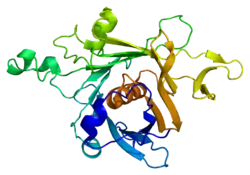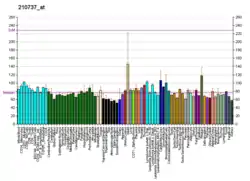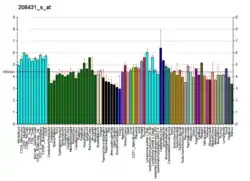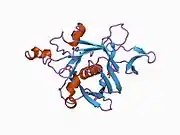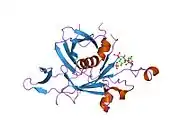TUB (gene)
Tubby protein homolog is a protein that in humans is encoded by the TUB gene.[5][6]
This gene encodes a member of the Tubby family of bipartite transcription factors. The encoded protein may play a role in obesity and sensorineural degradation. The crystal structure has been determined for a similar protein in mouse, and it functions as a membrane-bound transcription regulator that translocates to the nucleus in response to phosphoinositide hydrolysis. Two transcript variants encoding distinct isoforms have been identified for this gene.[6]
References
- GRCh38: Ensembl release 89: ENSG00000166402 - Ensembl, May 2017
- GRCm38: Ensembl release 89: ENSMUSG00000031028 - Ensembl, May 2017
- "Human PubMed Reference:". National Center for Biotechnology Information, U.S. National Library of Medicine.
- "Mouse PubMed Reference:". National Center for Biotechnology Information, U.S. National Library of Medicine.
- Kleyn PW, Fan W, Kovats SG, Lee JJ, Pulido JC, Wu Y, Berkemeier LR, Misumi DJ, Holmgren L, Charlat O, Woolf EA, Tayber O, Brody T, Shu P, Hawkins F, Kennedy B, Baldini L, Ebeling C, Alperin GD, Deeds J, Lakey ND, Culpepper J, Chen H, Glucksmann-Kuis MA, Carlson GA, Duyk GM, Moore KJ (Jun 1996). "Identification and characterization of the mouse obesity gene tubby: a member of a novel gene family". Cell. 85 (2): 281–90. doi:10.1016/S0092-8674(00)81104-6. PMID 8612280. S2CID 15670925.
- "Entrez Gene: TUB tubby homolog (mouse)".
- Kapeller, R; Moriarty A; Strauss A; Stubdal H; Theriault K; Siebert E; Chickering T; Morgenstern J P; Tartaglia L A; Lillie J (Aug 1999). "Tyrosine phosphorylation of tub and its association with Src homology 2 domain-containing proteins implicate tub in intracellular signaling by insulin". J. Biol. Chem. UNITED STATES. 274 (35): 24980–6. doi:10.1074/jbc.274.35.24980. ISSN 0021-9258. PMID 10455176.
Further reading
- Ikeda A, Nishina PM, Naggert JK (2002). "The tubby-like proteins, a family with roles in neuronal development and function". J. Cell Sci. 115 (Pt 1): 9–14. PMID 11801719.
- Jones JM, Meisler MH, Seldin MF, et al. (1992). "Localization of insulin-2 (Ins-2) and the obesity mutant tubby (tub) to distinct regions of mouse chromosome 7". Genomics. 14 (1): 197–9. doi:10.1016/S0888-7543(05)80308-8. hdl:2027.42/29864. PMID 1358794.
- North MA, Naggert JK, Yan Y, et al. (1997). "Molecular characterization of TUB, TULP1, and TULP2, members of the novel tubby gene family and their possible relation to ocular diseases". Proc. Natl. Acad. Sci. U.S.A. 94 (7): 3128–33. Bibcode:1997PNAS...94.3128N. doi:10.1073/pnas.94.7.3128. PMC 20333. PMID 9096357.
- Kapeller R, Moriarty A, Strauss A, et al. (1999). "Tyrosine phosphorylation of tub and its association with Src homology 2 domain-containing proteins implicate tub in intracellular signaling by insulin". J. Biol. Chem. 274 (35): 24980–6. doi:10.1074/jbc.274.35.24980. PMID 10455176.
- Boggon TJ, Shan WS, Santagata S, et al. (1999). "Implication of tubby proteins as transcription factors by structure-based functional analysis". Science. 286 (5447): 2119–25. doi:10.1126/science.286.5447.2119. PMID 10591637. S2CID 33506220.
- He W, Ikeda S, Bronson RT, et al. (2001). "GFP-tagged expression and immunohistochemical studies to determine the subcellular localization of the tubby gene family members". Brain Res. Mol. Brain Res. 81 (1–2): 109–17. doi:10.1016/S0169-328X(00)00164-9. PMID 11000483.
- Santagata S, Boggon TJ, Baird CL, et al. (2001). "G-protein signaling through tubby proteins". Science. 292 (5524): 2041–50. doi:10.1126/science.1061233. PMID 11375483. S2CID 29856557.
- Strausberg RL, Feingold EA, Grouse LH, et al. (2003). "Generation and initial analysis of more than 15,000 full-length human and mouse cDNA sequences". Proc. Natl. Acad. Sci. U.S.A. 99 (26): 16899–903. Bibcode:2002PNAS...9916899M. doi:10.1073/pnas.242603899. PMC 139241. PMID 12477932.
- Gerhard DS, Wagner L, Feingold EA, et al. (2004). "The status, quality, and expansion of the NIH full-length cDNA project: the Mammalian Gene Collection (MGC)". Genome Res. 14 (10B): 2121–7. doi:10.1101/gr.2596504. PMC 528928. PMID 15489334.
- Shiri-Sverdlov R, Custers A, van Vliet-Ostaptchouk JV, et al. (2006). "Identification of TUB as a novel candidate gene influencing body weight in humans". Diabetes. 55 (2): 385–9. doi:10.2337/diabetes.55.02.06.db05-0997. PMID 16443771.
- Giannaccini G, Giusti L, Santini F, et al. (2007). "Tubby protein in human lymphocytes from normal weight and obese subjects". Clin. Biochem. 40 (11): 806–9. doi:10.1016/j.clinbiochem.2007.03.020. PMID 17498679.
External links
- Overview of all the structural information available in the PDB for UniProt: P50607 (Human Tubby protein homolog) at the PDBe-KB.
- Overview of all the structural information available in the PDB for UniProt: P50586 (Mouse Tubby protein) at the PDBe-KB.
This article is issued from Wikipedia. The text is licensed under Creative Commons - Attribution - Sharealike. Additional terms may apply for the media files.
